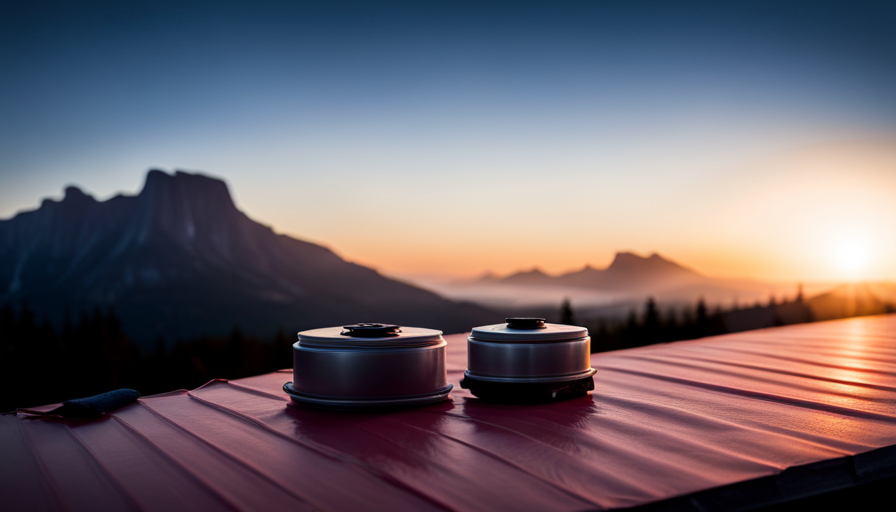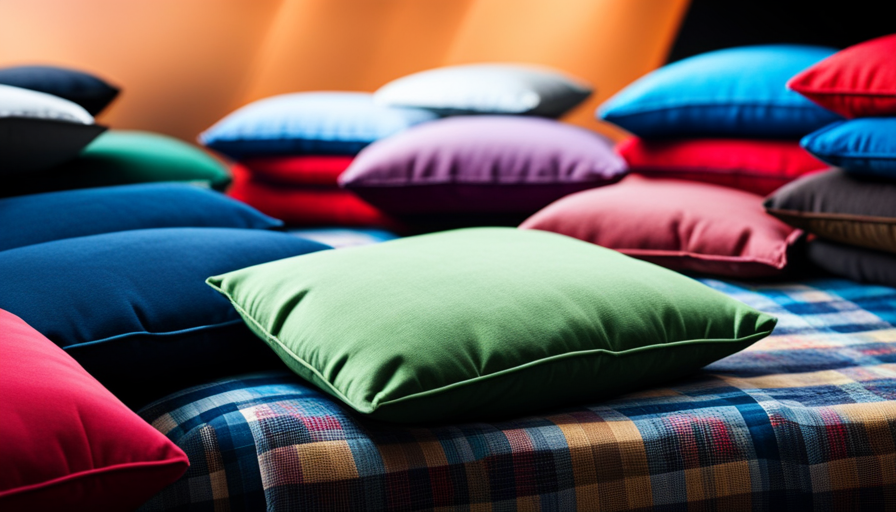Imagine being on a serene camping journey, enveloped by the stunning calm of nature. As you enjoy your coffee, the fresh morning breeze rejuvenates you while you are captivated by the beautiful scenery. Without warning, ominous clouds gather, posing a risk to your idyllic retreat. However, there’s no need to worry! Equipped with the proper skills and equipment, you can keep your camper roof in top condition, ready to face any tempest.
When it comes to sealing your camper roof, there are a variety of options to choose from. From silicone sealant and liquid roof coating to butyl tape and EPDM roofing membrane, each option serves a specific purpose in keeping your roof watertight. Whether you’re dealing with cracks, leaks, or simply preventative maintenance, these tried-and-true methods will have your camper ready to withstand the elements.
In this article, we will explore the different sealing techniques available, providing you with a comprehensive guide on what to use to seal your camper roof.
So, let’s dive in and ensure your camping adventures remain dry and worry-free!
Key Takeaways
- Silicone sealant and EPDM roofing membrane are popular options for sealing camper roofs due to their durability, flexibility, and resistance to UV rays and extreme weather conditions.
- Liquid roof coating is an effective choice for extending the lifespan of a camper’s roof, providing a seamless barrier against water seepage, and protecting against sun damage.
- Butyl tape and self-adhesive sealants are easy to install and create a strong bond between different roof materials, making them highly effective in sealing gaps and preventing leaks.
- RV Roof Tape and Eternabond Tape provide long-lasting protection against the elements, with easy application and excellent adhesion to various roofing materials.
Silicone Sealant
To seal your camper roof, you can use silicone sealant, which creates a waterproof barrier. Silicone sealant is a popular choice for sealing camper roofs because it’s durable, long-lasting, and resistant to UV rays and extreme weather conditions. It adheres well to various materials commonly used in camper roofs, such as metal, fiberglass, and rubber.
One of the advantages of using silicone sealant is its flexibility. It can accommodate the natural movements of your camper while on the road without cracking or peeling. This flexibility helps prevent leaks and maintain the integrity of your camper roof. Additionally, silicone sealant is easy to apply and requires minimal maintenance, making it a convenient option for sealing your camper roof.
While silicone sealant is a reliable choice, it’s important to consider alternative options based on your specific needs. For instance, liquid roof coating is another effective method for sealing camper roofs. This coating forms a seamless membrane that provides excellent protection against water damage. It’s particularly suitable for older campers or those with extensive roof damage.
In the subsequent section about liquid roof coating, we’ll explore this alternative option in more detail and discuss its benefits and application process.
Liquid Roof Coating
Applying a liquid roof coating can extend the lifespan of your camper’s top by up to 10 years. This versatile solution provides numerous benefits that will help protect your camper from the elements and ensure its longevity.
Here are five reasons why liquid roof coating is the ideal choice for sealing your camper’s roof:
-
Waterproof: Liquid roof coating forms a seamless barrier that effectively prevents water from seeping through, keeping your camper dry even during heavy rainfall.
-
UV Protection: The coating contains UV inhibitors that shield your camper’s roof from harmful sun rays, preventing premature aging and cracking.
-
Energy Efficiency: By reflecting the sun’s heat, the coating helps to keep the interior of your camper cool, reducing the need for excessive air conditioning and saving energy.
-
Easy Application: Applying liquid roof coating is a straightforward process that can be done by most DIY enthusiasts. Just follow the manufacturer’s instructions for a successful application.
-
Cost-effective: Compared to other roof sealing options, liquid roof coating provides excellent bang for your buck. It’s a cost-effective solution that offers long-lasting results.
Now, let’s move on to the next section and explore the benefits of using butyl tape for sealing your camper’s roof.
Butyl Tape
Butyl tape is a self-adhesive product that’s easy to install, making it an ideal choice for sealing camper roofs. It creates a strong bond between different roof materials, ensuring a secure and long-lasting seal.
Additionally, butyl tape is highly effective in sealing gaps and preventing leaks, providing peace of mind during rainy camping trips.
Self-adhesive and easy to install
Use a self-adhesive sealant that’s quick and easy to install on your camper roof. Self-adhesive sealants offer several advantages over traditional ones. They eliminate the need for messy application processes, like mixing and spreading. With a self-adhesive sealant, you simply peel off the backing and stick it directly onto the roof surface. This makes the installation process much faster and more convenient, especially for DIY enthusiasts.
Additionally, self-adhesive sealants create a strong bond between the roof materials, ensuring a watertight seal that lasts. The adhesive properties of these sealants help prevent leaks and protect your camper from water damage. By choosing a self-adhesive sealant, you can confidently seal your camper roof, knowing it’ll be securely and effectively protected.
Creates a strong bond between roof materials
Stick with a self-adhesive sealant and watch as it weaves a resilient bond between the layers of your shelter, ensuring a fortress against water and time. Using a high-quality roof sealant creates a strong bond that can withstand the elements and protect your camper from leaks and damage.
This type of sealant is specifically designed to adhere to various roof materials, such as rubber, metal, or fiberglass, creating a tight and long-lasting seal. Its self-adhesive nature makes it easy to install, eliminating the need for additional tools or complicated procedures.
By choosing a self-adhesive sealant, you can confidently seal your camper’s roof, knowing that it will provide excellent protection for years to come. This type of sealant is also highly effective in sealing gaps and preventing leaks, ensuring a watertight seal for your camper.
Effective in sealing gaps and preventing leaks
By opting for a self-adhesive sealant, you’ll witness its remarkable ability to seal gaps and keep leaks at bay, ensuring a well-protected and watertight shelter. Preventing roof leaks is crucial for maintaining the integrity of your camper roof. Regular roof maintenance is of utmost importance to identify and address any potential issues before they become major problems.
A self-adhesive sealant is effective in sealing gaps and preventing leaks because it creates a strong bond between roof materials, providing a durable and long-lasting solution. It’s easy to apply, requiring minimal effort and time. Additionally, it’s resistant to harsh weather conditions, including UV rays and temperature fluctuations. This makes it a reliable choice for sealing your camper roof. However, for more severe damage or larger gaps, roofing cement may be necessary.
Roofing Cement
Roofing cement is like a superhero for your camper’s roof, providing an impenetrable shield against leaks and water damage. When it comes to sealing gaps and preventing leaks, there are several alternatives to roofing cement, each with their own pros and cons. However, roofing cement stands out as an effective and reliable choice.
One advantage of roofing cement is its ease of application. It can be easily spread over the roof surface and into gaps, ensuring a seamless seal. Additionally, it has a long-lasting durability, capable of withstanding harsh weather conditions and preventing water from seeping through.
Another benefit of roofing cement is its affordability. Compared to other sealing methods, such as epdm roofing membrane, roofing cement is generally more cost-effective. This makes it a practical solution for those on a budget, without compromising on quality and effectiveness.
Roofing cement is a tried and true method for sealing camper roofs. Its ease of application, durability, and affordability make it a top choice for many camper owners.
However, if you’re looking for an alternative solution, the next section will explore the benefits of using epdm roofing membrane.
EPDM Roofing Membrane
EPDM roofing membrane offers a reliable and cost-effective solution for protecting your camper’s roof from leaks and water damage. It is a popular choice among camper owners due to its flexibility and durability. One of the key benefits of EPDM membrane is its ease of installation. With a little knowledge and the right tools, you can easily install EPDM membrane on your camper’s roof.
EPDM membrane is known for its excellent weather resistance, making it ideal for campers that are constantly exposed to the elements. It can withstand extreme temperatures, UV rays, and even hailstorms, providing long-lasting protection. Additionally, EPDM membrane is highly resistant to water, preventing leaks and water damage.
Another advantage of EPDM membrane is its low maintenance requirements. Once installed, it requires minimal upkeep, saving you time and money. This makes it a cost-effective choice for camper owners.
As we transition into the subsequent section about acrylic roof coating, it’s important to note that EPDM membrane can be further protected and enhanced by applying an acrylic roof coating. This additional layer provides extra durability and extends the lifespan of your camper’s roof.
Acrylic Roof Coating
Enhance and protect your camper’s roof with the application of an acrylic roof coating, giving it an extra layer of armor and extending its lifespan. Acrylic roof coating is a popular choice among RV owners due to its numerous benefits.
- It provides excellent protection against UV rays, preventing damage and deterioration caused by prolonged exposure to the sun.
- Acrylic roof coating is highly flexible, allowing it to expand and contract with temperature changes, reducing the risk of cracking and leaks.
- It forms a seamless barrier that prevents water penetration, keeping your camper dry and free from water damage.
However, there are some drawbacks to consider. Acrylic roof coating may require more frequent reapplication compared to other types of coatings, depending on the climate and condition of your camper’s roof.
When applying acrylic roof coating, it’s crucial to clean the roof thoroughly and ensure it’s dry before starting. Use a high-quality brush or roller for an even and smooth application.
The lifespan of acrylic roof coating can vary depending on various factors, such as weather conditions and maintenance. On average, it can last between five to ten years before needing to be reapplied.
In terms of cost, acrylic roof coating is a cost-effective option compared to other roofing materials. It provides long-lasting protection at a reasonable price.
Transitioning into the subsequent section about RV roof tape, it’s important to explore alternative options for sealing your camper’s roof.
RV Roof Tape
RV Roof Tape is a fantastic option for sealing small leaks and cracks on your camper roof. We’ve found it to be extremely easy to use and apply, making it a great DIY solution. Not only does it create a strong and flexible seal, but it also provides long-lasting protection against the elements.
Easy to use and apply
When it comes to sealing your camper roof, you’ll love how effortless it is to apply and use. Here are four reasons why the application process is a breeze and provides long-lasting protection:
-
Simple Application: The sealant is designed to be user-friendly, allowing you to easily apply it without any special tools or expertise.
-
Quick Drying: Once applied, the sealant dries rapidly, saving you time and ensuring that your roof is protected in no time.
-
Effective Adhesion: The sealant adheres firmly to the roof surface, creating a strong bond that prevents leaks and water damage.
-
Weather Resistance: It withstands various weather conditions, including UV rays, heavy rain, and extreme temperatures, ensuring your camper remains protected throughout the year.
With its easy application and long-lasting protection, this sealant creates a strong and flexible seal that’ll keep your camper roof secure for years to come.
Creates a strong and flexible seal
Crafting a robust and adaptable bond, this sealant ensures your cherished camper’s top remains secure and worry-free. When it comes to sealing a camper roof, there are various flexible sealant options available in the market. However, it’s crucial to choose a sealant that not only creates a strong bond but also provides the flexibility needed to withstand the constant movement and vibrations experienced during travel.
A strong seal is essential to prevent water leaks and potential damage to the camper’s interior. By using a sealant that offers both strength and flexibility, you can have peace of mind knowing that your camper’s roof is well protected against the elements. This type of sealant is also suitable for repairing small leaks and cracks, ensuring your camper stays in top condition for all your adventures ahead.
Transitioning to the next section, let’s discuss how this sealant can effectively address those pesky leaks and cracks.
Suitable for repairing small leaks and cracks
Ensure your cherished camper’s top remains worry-free by utilizing this sealant’s ability to effectively repair small leaks and cracks, guaranteeing your adventures ahead are free from unexpected water intrusions.
When it comes to repairing small leaks and cracks on your camper roof, it’s essential to use a sealant that’s not only strong but also flexible. This sealant is specifically designed to provide a durable and long-lasting solution for common roof problems. With its advanced repair techniques, it can easily mend small leaks and cracks, preventing further damage and costly repairs.
Here are three reasons why this sealant is suitable for repairing small leaks and cracks:
- It forms a tight and waterproof seal, ensuring no water can penetrate through.
- It’s highly flexible, allowing it to expand and contract with the camper’s movement.
- It provides excellent adhesion to various roofing materials, ensuring a secure and long-lasting repair.
By using this sealant, you can confidently address any small leaks or cracks on your camper roof, extending its lifespan and ensuring a worry-free camping experience.
Speaking of effective repair solutions, let’s now explore the benefits of using Eternabond tape.
Eternabond Tape
Eternabond Tape is a fantastic option for sealing camper roofs as it provides a permanent and watertight seal. We’ve personally used this tape and found that it effectively seals leaks and prevents any further water damage.
Additionally, Eternabond Tape is versatile and can be applied to various surfaces, making it a convenient choice for any RV owner. Another great feature of this tape is its resistance to UV rays and extreme temperatures, ensuring that it remains durable and effective in all weather conditions.
Provides a permanent and watertight seal
For a foolproof way to keep your camper roof permanently sealed and watertight, you’ll find nothing better than Eternabond Tape. This incredible product is a permanent sealant that provides a waterproof solution like no other.
With its advanced adhesive technology and durable construction, it creates a bond that can withstand even the harshest weather conditions. Whether you’re dealing with rain, snow, or UV rays, Eternabond Tape will keep your camper roof protected for years to come.
What’s great about this product is that it can be applied to various surfaces, including metal, wood, and even rubber. So, no matter what type of camper roof you have, Eternabond Tape has got you covered.
Now, let’s delve into how easy it is to apply this amazing product.
Can be applied to various surfaces
With its versatility, Eternabond Tape can easily adhere to different materials, such as metal, wood, and rubber, providing a reliable and durable seal. Applying sealant correctly is crucial to ensure a watertight and long-lasting solution for your camper roof.
There are different types of sealants available, including liquid sealants, caulks, and tapes. However, Eternabond Tape stands out due to its ease of application and its ability to bond with various surfaces. Whether you have a metal, wood, or rubber roof, this tape provides a permanent seal that can withstand the elements. Its strong adhesive properties ensure a tight bond, preventing water and moisture from seeping through. This makes Eternabond Tape an ideal choice for sealing camper roofs.
Transitioning into the next section, it’s also important to note that this tape is resistant to UV rays and extreme temperatures, ensuring its longevity in any weather conditions.
Resistant to UV rays and extreme temperatures
Imagine a tape that can withstand scorching sun rays and freezing temperatures, ensuring a long-lasting and durable seal. When it comes to sealing a camper roof, it’s crucial to choose a product that’s resistant to UV rays and extreme temperatures. This is because the roof is constantly exposed to the sun’s harmful rays and extreme weather conditions. By using a sealant that’s specifically designed to withstand these elements, you can ensure that your camper roof remains protected and well-sealed for years to come.
One such product that fits the bill is a high-quality polyurethane sealant. This sealant provides excellent resistance to UV rays and extreme temperatures, making it an ideal choice for sealing camper roofs. With its superior durability and weather resistance, it offers reliable protection for your camper roof, ensuring a worry-free camping experience.
Polyurethane Sealant
Polyurethane sealant is an excellent choice for sealing various surfaces due to its ability to form a strong and flexible seal. This sealant is highly resistant to weathering and aging, making it a durable option for long-term use.
Whether you need to seal a camper roof or any other application, polyurethane sealant is a versatile solution that can be trusted to provide reliable protection.
Forms a strong and flexible seal
Create a robust and flexible seal by using a high-quality sealant on your camper roof. When it comes to sealing your camper roof, there are two popular options to consider: silicone and butyl. Both have their pros and cons.
Silicone sealant is known for its excellent adhesion and resistance to UV rays, making it a great choice for long-term durability. On the other hand, butyl sealant is more affordable and easy to work with, although it may not last as long as silicone.
Whichever option you choose, here are some application tips and best practices to ensure a successful seal:
- Clean the roof thoroughly before applying the sealant.nn2. Apply the sealant evenly and generously, making sure to cover any cracks or gaps.nn3. Use a caulking gun for precise and controlled application.nn4. Allow the sealant to cure completely before exposing it to water or extreme weather conditions.
By following these guidelines, you can create a strong and flexible seal that will protect your camper roof for years to come. Moving on to the next section, it’s important to note that a high-quality sealant is also resistant to weathering and aging.
Resistant to weathering and aging
Despite their claims of durability, sealants often fail to live up to their promises of being resistant to weathering and aging. However, there are certain materials and weatherproofing techniques that can provide a long-lasting solution.
It is crucial to choose sealants that are specifically designed to be resistant to weathering. Look for products that are made from durable and weather-resistant materials such as silicone or polyurethane. These materials have been proven to withstand harsh weather conditions and prevent water damage.
Additionally, consider using weatherproofing techniques such as applying multiple layers of sealant or using reinforcing tapes to ensure a strong and flexible seal. By utilizing these resistant materials and weatherproofing techniques, you can effectively protect your camper roof from the damaging effects of weathering and aging.
This makes them suitable for a wide range of applications, including sealing camper roofs.
Suitable for a wide range of applications
You’ll be amazed at the versatility of these sealants, as they’re perfect for a wide range of applications. Whether you need to seal your camper roof, repair a leaky pipe, or protect your wooden deck, these sealants have got you covered.
They’re suitable for both indoor and outdoor use, making them ideal for all kinds of projects. When it comes to sealing a camper roof, these sealants are the go-to choice. Their liquid coating formula creates a waterproof barrier that effectively prevents leaks and protects your camper from the elements.
With their easy application and long-lasting durability, these sealants ensure that your camper roof stays in top shape for years to come.
Now, let’s move on to the next section and discuss the benefits of using an RV roof coating kit.
RV Roof Coating Kit
Although it may seem like a small step, applying an RV Roof Coating Kit is like giving your camper a protective shield, ensuring that it remains intact against the elements and ready for countless adventures.
When it comes to RV roof maintenance, choosing the right coating is crucial. There are various options available, each with its own pros and cons.
One of the top choices among RV enthusiasts is the RV Roof Coating Kit. This kit is specially designed to provide long-lasting protection and durability to your camper’s roof. It’s easy to apply and can be done by anyone, even those without prior experience. The kit typically includes all the necessary materials, such as the coating itself, a primer, and a sealing tape.
One of the major advantages of using an RV Roof Coating Kit is its versatility. It can be applied to different types of roofs, including rubber, fiberglass, and metal. This means that no matter what type of roof your camper has, this kit will work effectively. Additionally, the coating provides excellent resistance against UV rays, preventing damage and deterioration over time.
However, it’s important to consider the cons as well. The main disadvantage of using an RV Roof Coating Kit is the cost. Compared to other options, such as liquid roof coatings, the kit can be more expensive. Additionally, the application process may require some time and effort, especially if you have a larger camper.
An RV Roof Coating Kit is an excellent choice for maintaining and protecting your camper’s roof. It offers durability, versatility, and resistance to the elements. However, it’s important to weigh the pros and cons before making a decision.
Frequently Asked Questions
Can I use silicone sealant on any type of camper roof?
Yes, there are several sealing methods that can be used on camper roofs. While silicone sealant is commonly used, it may not be suitable for all types of camper roofs. Alternatives to silicone include acrylic sealants, butyl tape, and roof coatings. Acrylic sealants provide a flexible and durable seal, but they may require reapplication over time. Butyl tape offers excellent adhesion and is easy to use. Roof coatings provide an additional layer of protection and can be applied on various types of camper roofs.
How long does liquid roof coating typically last before needing to be reapplied?
When it comes to liquid roof coatings, the duration before reapplication depends on various factors. However, with proper regular maintenance, you can extend its lifespan significantly.
Regular inspections and roof cleaning are essential to identify signs that indicate it’s time to reapply the coating. These signs may include cracks, peeling, or discoloration. By addressing these issues promptly and reapplying the liquid roof coating as needed, you can ensure the long-lasting protection and waterproofing of your camper roof.
Is butyl tape a permanent solution for sealing camper roofs?
Butyl tape is a commonly used solution for sealing camper roofs, but it may not be a permanent one. While it provides a strong initial seal, it can deteriorate over time due to exposure to UV rays and weather conditions.
Alternatives to butyl tape include liquid roof coatings and rubber roof membranes. These options offer longer-lasting protection and can withstand the elements more effectively. However, each option has its pros and cons, so it’s important to carefully consider your specific needs before making a decision.
Can roofing cement be used to repair small leaks on an EPDM roofing membrane?
Roofing cement is a suitable option for repairing small leaks on an EPDM roofing membrane, commonly found on camper roofs. It provides a durable and long-lasting solution by effectively sealing the leaks.
The cement is designed to adhere to the EPDM material, ensuring a secure bond and preventing any further water damage. It’s crucial to apply the cement carefully, following the manufacturer’s instructions, to ensure a successful repair.
Properly sealing camper roof leaks is essential to maintain the integrity of the EPDM roofing membrane.
Are acrylic roof coatings suitable for all types of camper roofs?
Acrylic roof coatings offer an excellent solution for sealing camper roofs. They’re suitable for all types of camper roofs, providing a durable and waterproof barrier.
These coatings are specifically designed to withstand the harsh outdoor elements, including UV rays and extreme weather conditions. Additionally, acrylic roof coatings offer flexibility, allowing them to expand and contract with temperature changes without compromising their integrity.
For added protection, it’s recommended to use silicone sealant in conjunction with the acrylic roof coating to ensure a complete and long-lasting seal.
Conclusion
In conclusion, when it comes to sealing your camper roof, there are several options available. From silicone sealant to liquid roof coating, butyl tape to roofing cement, the choices can be overwhelming. However, it’s important to choose a product that’s durable, long-lasting, and easy to apply. So, which one should you use? Well, I can’t reveal the answer just yet.
But stay tuned for our next article, where we’ll unveil the ultimate solution to sealing your camper roof. Trust me, you won’t want to miss it.



















